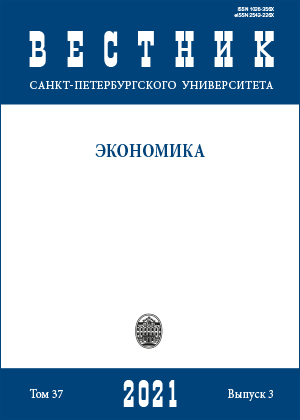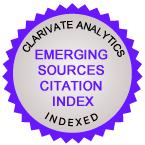Оценка чувствительности рынков капитала к развитию пандемии COVID-19
DOI:
https://doi.org/10.21638/spbu05.2021.305Аннотация
Авторами статьи проведен анализ показателей отраслевых субиндексов на обозримом отрезке времени пандемии COVID-19, реализованный на основе оценки динамики норм доходности 247 отраслевых индексов из 15 европейских стран в 2020 г. Исследованы различия между достигнутыми нормами доходности промышленности и основными фондовыми индексами во всех исследуемых странах. Кроме того, была рассчитана волатильность отдельных отраслевых индексов. Результаты проведенного исследования позволяют сделать следующие выводы. Во-первых, туризм, нефтегазовый и финансовый сектор относятся к числу отраслей, которые инвесторы считают наиболее уязвимыми для COVID-19. Во-вторых, необходимость перевода бизнеса в Интернет, а также ускорение (отчасти вынужденное) цифровой трансформации бизнеса являются предпосылками для принятия инвесторами решений об увеличении доли технологических компаний в своих портфелях. С другой стороны, растущая неопределенность влияет на работу поставщиков продовольствия и других предметов первой необходимости. Из-за административных ограничений, наложенных на туристическую и пассажирскую транспортную деятельность, спрос на товары для отдыха быстро возрос, что отразилось на результатах и котировках предприятий, ответственных за их производство. Пандемический кризис, вопреки наблюдавшимся в 1-м квартале 2020 г. симптомам и ожиданиям аналитиков, не оказал негативного влияния на промышленное производство. В-третьих, в целом поведение инвесторов на российском рынке было аналогично поведению инвесторов в других исследуемых экономиках. Однако по трем подсекторам экономики реакция инвесторов была разной.
Ключевые слова:
COVID-19, рынки капитала, секторный риск
Скачивания
Библиографические ссылки
References
Albuquerque R. A., Koskinen Y., Yang S., Zhang C. (2020) Resiliency of environmental and social stocks: An analysis of the exogenous COVID-19 market crash. The Review of Corporate Finance Studies, vol. 9,iss. 3, pp. 593–621. https://doi.org/10.1093/rcfs/cfaa011
Alfaro L., Chari A., Greenland A., Schott P. K. (2020) Aggregate and firm-level stock returns during pandemics, in real time. NBER, Working Papers, no. 26950, pp. 1–31. URL: http://www.nber.org/papers/w26950(accessed: 06.10.2020).
Babuna P., Yang X., Gyilbag A., Awudi D., Ngmenbelle D., Bian D. (2020) The Impact of COVID-19 on the Insurance Industry. International Journal of Environmental Research and Public Health, no 17 (5766), pp. 1–14. https://doi.org/10.3390/ijerph17165766
Bagchi B., Chatterjee S., Ghosh R., Dandapat D. (2020) “Impact of COVID-19 on Global Economy” in Bagchi B., Chatterjee S., Ghosh R., Dandapat D. Coronavirus Outbreak and the Great Lockdown. Springer, pp. 15–26. https://doi.org/10.1007/978-981 15-7782-6_3
Baker S. R., Bloom N., Davis S. J., Terry S. J. (2020) COVID-Induced Economic Uncertainty. NBER, Working Papers, no. 26983, pp. 1–17.
Benedyczak J., Zaniewicz M. (2020) Gospodarka rosyjska w czasie COVID-19. Biuletyn PISM, no 159. URL: https://www.pism.pl/publikacje/Gospodarka_rosyjska_w_czasie_COVID19 (accessed 30.03.2021).
Boissay F., Rungcharoenkitkul P. (2020) Macroeconomic effects of Covid-19: an early review. BIS Bulletin, no. 7, pp. 1–9. URL: https://www.bis.org/publ/bisbull07.htm (accessed: 04.05.2020).
Chang Ch., McAleer M., Wong W.-K. (2020) Risk and Financial Management of COVID-19 in Business, Economics and Finance. Journal of Risk and Financial Management, vol. 13, no. 5 (102), pp. 1–7.https://doi.org/10.3390/jrfm13050102
Coibion O., Gorodnichenko Y., Weber M. (2020) Labor markets during the covid-19 crisis: A preliminary view. NBER Working Papers, no. 27017, pp. 1–15. https://doi.org/10.3386/w27017
Czech K., Wielechowski M. (2021) Is the Alternative Energy Sector COVID-19 Resistant? Comparison with the Conventional Energy Sector: Markov Switching Model Analysis of Stock Market Indices of Energy Companies. Energies, vol. 14, no. 4 (988), pp. 1–17. https://doi.org/10.3390/en14040988
Demirguc-Kunt A., Pedraza A., Ruiz C. (2020) Banking sector performance during the COVID-19 Crisis. World Bank, Policy Research Working Paper Series, no. 9363, pp. 1–55. URL: https://openknowledge.worldbank.org/handle/10986/34369 (accessed: 28.09.2020).
Dhall R., Singh B. (2020) The COVID-19 Pandemic and Herding Behaviour: Evidence from India’s Stock Market. Millennial Asia, vol. 11, iss. 3, pp. 366–390. https://doi.org/10.1177/0976399620964635
Ding W., Levine R., Lin Ch., Xie W. (2020) Corporate immunity to the COVID-19 pandemic. NBER, Working Paper, no. 27055, pp. 1–54. URL: http://www.nber.org/papers/w27055 (accessed: 07.02.2021).
Espejo W., Celis J. E., Chiang G., Bahamonde P. (2020) Environment and COVID-19: Pollutants, impacts, dissemination, management and recommendations for facing future epidemic threats. Science of The Total Environment, vol. 747, no. 141314. https://doi.org/10.1016/j.scitotenv.2020.141314
Gamil Y., Alhagar A. (2020) The Impact of Pandemic Crisis on the Survival of Construction Industry: A Case of COVID-19. Mediterranean Journal of Social Sciences, no. 11, pp. 2039–2117. https://doi.org/10.36941/mjss-2020-0047
Gerding F., Martin, T., Nagler F. (2020) Sovereign Debt and Equity Returns in the Face of Disaster, pp. 1–48. https://doi.org/10.2139/ssrn.3572839
Gherghina Ș. C., Armeanu D. Ș., Joldeș C. C. (2020) Stock Market Reactions to COVID-19 Pandemic Outbreak: Quantitative Evidence from ARDL Bounds Tests and Granger Causality Analysis. International Journal of Environmental Research and Public Health, vol. 17, no. 18 (6729), pp. 1–35. https://doi.org/10.3390/ijerph17186729
Golubkova K., Ostroukh A. (2021) Russian banking sector ready to live without COVID-19 support. Reuters, February 18. URL: https://www.reuters.com/article/russia-cenbank-banks-idUSL8N2KO32D (accessed: 05.04.2021).
Gormsen N. J., Koijen R. S. J. (2020) Coronavirus: Impact on stock prices and growth expectations. Working Paper, University of Chicago, Becker Friedman Institute of Economics, no. 2020–22, pp. 1–34. https://doi.org/10.2139/ssrn.3555917
Guttmann R., Lawson D., Rickards P. (2020) The Economic Effects of Low Interest Rates and Unconventional Monetary Policy. Reserve Bank of Australia, pp. 1–10. URL: https://www.rba.gov.au/publications/bulletin/2020/sep/the-economic-effects-of-low-interest-rates-and-unconventional-monetary-policy. html (accessed: 21.03.2021).
Hassan T. A., Hollander S., van Lent L., Tahoun A. (2020) Firm-level exposure to epidemic diseases: COVID-19, SARS, and H1N1. Working Paper, Institute for New Economic Thinking, no. 119, pp. 1–46.https://doi.org/10.36687/inetwp119
Hutchinson J., Mee S. (2020) The impact of the ECB’s monetary policy measures taken in response to the COVID-19 crisis. ECB, Economic Bulletin, no 5/2020. URL: https://www.ecb.europa.eu/pub/economic-bulletin/focus/2020/html/ecb.ebbox202005_03~12b5ff68bf.en.html (accessed: 23.02.2021).
Jean S. (2020) How the COVID-19 Pandemic Is Reshaping the Trade Landscape and What to Do About It. Intereconomics, 55 (3), pp. 135–139. URL: https://www.intereconomics.eu/contents/year/2020/number/3/article/how-the-covid-19-pandemic-is-reshaping-the-trade-landscape-and-what-todoabout-it.html (accessed: 19.06.2021).
Kohlscheen E., Mojon B., Rees D. (2020) The macroeconomic spillover effects of the pandemic on the global economy. BIS, Bulletin no. 4, pp. 1–9. URL: https://www.bis.org/publ/bisbull04.htm (accessed: 02.12.2020).
Korzeb Z., Niedziółka P., Silva A. (2021a) Impact of the COVID-19 crisis on the Portuguese banking system. Linear ordering method. Estudios Gerenciales, vol. 37, no. 159, pp. 226–241. https://doi.org/10.18046/j.estger.2021.159.4414
Korzeb Z., Niedziółka P. (2021b) Determinants of Differentiation of Cost of Risk (CoR) among Polish Banks during COVID-19 Pandemic. Journal of Risk and Financial Management, vol. 14, no. 3 (110). https://doi.org/10.3390/jrfm14030110
Korzeb Z., Niedziółka P. (2020) Resistance of commercial banks to the crisis caused by the COVID-19 pandemic: the case of Poland. Equilibrium. Quarterly Journal of Economics and Economic Policy, vol. 15, iss. 2, pp. 205–234. https://doi.org/10.24136/eq.2020.010
Kulińska-Sadłocha E., Marcinkowska M., Szambelańczyk J. (2020) The impact of pandemic risk on the activity of banks based on the Polish banking sector in the face of COVID-19. Safe Bank, no. 2, pp. 31–59. https://doi.org/https://0.26354/bb.3.2.79.2020
Landier A., Thesmar D. (2020). Earnings expectations in the covid crisis. NBER, Working Papers, no. 27160, pp. 1–26. URL: http://www.nber.org/papers/w27160.pdf (accessed: 11.12.2020).
Machmuddah Z., Utomo S. D., Suhartono E., Ali S., Ali Ghulam W. (2020) Stock Market Reaction to COVID-19: Evidence in Customer Goods Sector with the Implication for Open Innovation. Journal of Open Innovation: Technology, Market, and Complexity, vol. 6, no. 4 (99). https://doi.org/10.3390/ joitmc6040099
Monteiro A., Eusébio C., Carneiro M. J., Madaleno M., Robaina M., Rodrigues V., Gama C., Relvas H., Russo M., Oliveira K., Lopes M., Borrego C. (2021) Tourism and Air Quality during COVID-19 Pandemic:Lessons for the Future. Sustainability, vol. 13, no. 7 (3906), pp. 1–22. https://doi.org/10.3390/ su13073906
Orhan Z. H., Tirman N. (2020) Analysis of the Impact of Covid-19 on Different Sectors in Turkey During Early Periods of the Pandemic. Journal of Business Research — Turk, no. 12, pp. 2312–2326. https://doi.org/10.20491/isarder.2020.978
Pagano M., Wagner Ch., Zechner J. (2020) Disaster Resilience and Asset Prices. CSEF, Working Papers,no. 563, pp. 1–45. URL:https://www.csef.it/WP/wp563.pdf (accessed: 02.04.2021).
Papadimitriou E., Cseres-Gergelyne Blaskó Z. (2020) Economic sectors at risk due to COVID-19 disruptions: will men and women in the EU be affected similarly. Publications Office of the European Union,pp. 1–21. https://doi.org/10.2760/50058
Salisu A. A., Ogbonna A. E., Oloko T. F., Adediran I. A. (2021) A New Index for Measuring Uncertainty Due to the COVID-19 Pandemic. Sustainability, vol. 13, no. 6 (3212), pp. 1–18. https://doi.org/10.3390/su13063212
Sansa N. The impact of the corona virus on the financial market: Evidence from China and U. S. A. (2020) Electronic Research Journal of Social Sciences and Humanities, vol. 2, iss. 2, pp. 1–11. https://doi.org/10.2139/ssrn.3567901
Stephany F., Stoehr N., Darius P., Neuhäuser L., Teutloff O., Braesemann F. (2020) Which industries are most severely affected by the COVID-19 pandemic? A data-mining approach to identify industry-specific risks in real-time. Working Paper. URL: https://www.researchgate.net/profile/PhilippDarius/publication/340271096_Which_industries_are_most_severely_affected_by_the_COVID19_pandemic_A_dataminingapproach_to_identify_industry-specific_risks_in_real-time/links/5e988938299bf13079a1a347/Which-industries-are-most-severelyaffected-by-the-COVID-19-pandemicA-data-mining-approach-to-identify-industry-specific-risks-in-real-time.pdf (accessed:14.03.2021).
Tsenzharik M., Krylova Y., Steshenko V. (2020) Digital transformation in companies: Strategic analysis, drivers and models. St Petersburg University Journal of Economic Studies, vol. 36, no. 3, pp. 390–420.https://doi.org/10.21638/spbu05.2020.303 (In Russian)
Valls Martínez M. d. C., Martín Cervantes P. A. (2021) Testing the Resilience of CSR Stocks during the COVID-19 Crisis: A Transcontinental Analysis. Mathematics, vol. 9, no. 5, (514), pp. 1–24. https://doi.org/10.3390/math9050514
Zhang D., Hu M., Ji Q. (2020) Financial markets under the global pandemic of COVID-19. Finance Research Letters, vol. 36, pp. 1–6. https://doi.org/10.1016/j.frl.2020.101528
Загрузки
Опубликован
Как цитировать
Выпуск
Раздел
Лицензия
Статьи журнала «Вестник Санкт-Петербургского университета. Экономика» находятся в открытом доступе и распространяются в соответствии с условиями Лицензионного Договора с Санкт-Петербургским государственным университетом, который бесплатно предоставляет авторам неограниченное распространение и самостоятельное архивирование.






